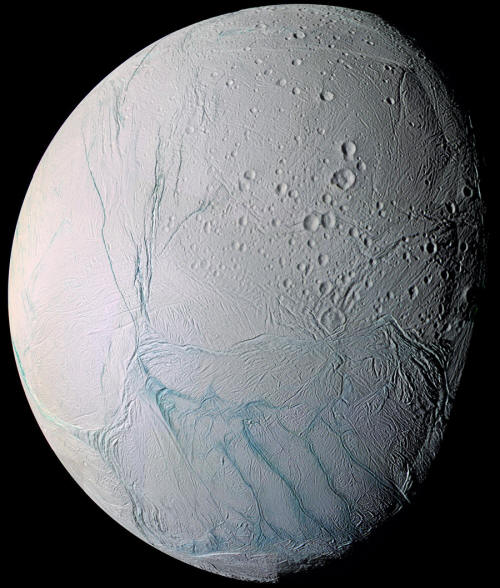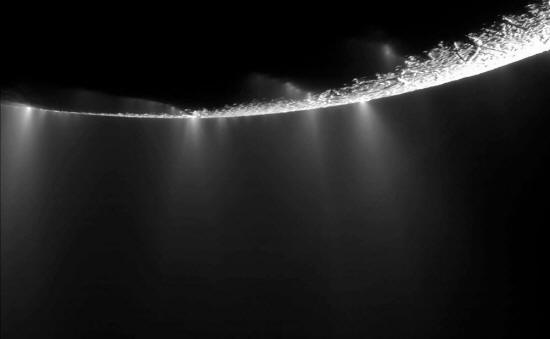|
from
Space website This enhanced-color image of Enceladus by NASA's Cassini spacecraft features the "tiger stripe" fractures, from which geysers blast water ice and other material
from the Saturn moon's subsurface ocean out into space.
Scientists think these
geysers are blasting material from a sizeable ocean buried beneath
the satellite's ice shell.
blast water ice, organic molecules and other material into space from the south polar region of Saturn’s moon Enceladus,
as seen
here by NASA’s Cassini spacecraft.
And the new study suggests that the satellite possesses another key ingredient as well: an energy source.
A team of researchers led by Hunter Waite, of the Southwest Research Institute (SwRI) in San Antonio, analyzed observations made by Cassini during an October 2015 dive through Enceladus' geyser plume.
This plunge was special in several ways. For one thing, it was Cassini's deepest-ever dive through the plume; the probe got within a mere 30 miles (49 km) of Enceladus' surface.
In addition, Cassini's Ion and Neutral Mass Spectrometer (INMS) instrument alternated between "open-source" and "closed-source" modes during the encounter, rather than sticking to closed source (the usual routine).
INMS is just 0.25 percent as sensitive in open-source mode as it is in closed-source mode, Waite and his colleagues wrote in the new Science paper (Cassini finds Molecular Hydrogen in the Enceladus Plume - Evidence for Hydrothermal Processes).
But open source has a key advantage:
With this analytical hurdle cleared, Waite and his team were able to calculate that H2 makes up between 0.4 percent and 1.4 percent of the volume of Enceladus' geyser plume.
Further calculations revealed that carbon dioxide (CO2) makes up an additional 0.3 percent to 0.8 percent of the plume's volume.
The molecular hydrogen is most likely being produced continuously by reactions between hot water and rock in and around Enceladus' core, Waite and his colleagues concluded.
They considered other possible explanations and found them wanting.
For example, neither Enceladus' ocean nor its ice shell are viable long-term reservoirs for volatile H2, the authors wrote, and processes that disassociate H2 from water ice in the shell don't seem capable of generating the volume measured in the plume.
The hydrothermal explanation is also consistent with a 2016 study by another research group, which concluded that tiny silica grains detected by Cassini could have been produced only in hot water at significant depths.
Deep-sea chemical reactions
Earth's deep-sea hydrothermal vents support rich communities of life, ecosystems powered by chemical energy rather than sunlight.
The inferred presence of H2 and CO2 in Enceladus' ocean therefore suggests that similar reactions could well be occurring deep beneath the moon's icy shell.
Indeed, the observed H2 levels indicate that a lot of chemical energy is potentially available in the ocean, Chris Glein said.
Glein stressed, however, that nobody knows whether such reactions are actually occurring on Enceladus.
Jeffrey Seewald also counseled caution on astrobiological interpretations.
He noted, for example, that molecular hydrogen is rare in Earth's seawater, because hungry microbes quickly gobble it up.
|



